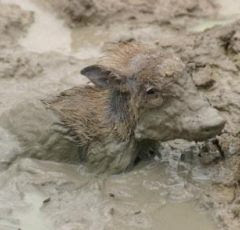On average, 80% of a perennial plants' mass is below the surface.
UBC Forestry Prof. Suzanne Simard's work on the wonders beneath the surface in a real forest mirrors global grassland studies done by Dr. Christine Jones of the Soil Carbon Coalition proving that in complex living soil, soil's organic matter and humus exude carbohydrates into the rooting zone, typically at night, which feed complex foodwebs. Further, that improving soil structure can increase the amount of carbon stored in soil.
"For atmospheric carbon dioxide to become soil carbon, it first needs to be captured by green plants in photosynthesis. Much of this carbon is released right back into the air by respiration or decay of plant material, or fire. But some of it can become soil organic matter. Perennial grasses, for example, periodically shed their roots into the soil. These dead roots feed complex soil foodwebs, and soil organic matter and humus can be the stable result." - Christine Jones, Phd
Perennials are thrifty. Their long roots hold on to soil, water, and fertilizer, which means less pollution as well as the ability to suck GHGs out of the atmosphere and sequester them back in the soil where they belong. Perennial plants are usually better than annual plants due to the development of larger root systems which can access water and soil nutrients deeper in the soil and to earlier emergence in the spring.
Many people have built new topsoil in their vegetable or flower gardens including the writer of these lines. In order for new soil to form, it must be living. Life in the soil provides the structure for more life, and the formation of more soil. From Australia where research on the Yeoman's farm has shown that the reestablishment of native perennial grasses was able to produce 10 cm of friable black soil within three years, on what was previously degraded soil on the North Richmond farm.
As Naomi Klein said recently, “I think what gives me most hope is the fact that this crisis is being increasingly understood not just as an economic criss but really as a spiritual crisis. The idea of humans having a divine right to dominate the earth and being outside the community of living things and living systems is at the heart of the crisis.” Adding,"It does necessitate a new understanding — or an older understanding — of our role in the world. One that says, no, we were never free from nature, nor should we be. We are of nature, we are of community and we need relationships that are founded on that premise. And as Vandana Shiva says, "We are soil."
From forests to grasslands to gardens, on every scale from backyard to global, each of us must act in parallel as part of the solution to the destruction being wrought by short-sighted capitalism's death grip on the planet. This message of hope is just as valid anywhere as everywhere. Each of us can be part of the solution to the destruction of the web of life that supports all life by first realizing the truth underlying Klein's message that we - flora, fauna, microbes, minerals, forces and faeries - are all in this together.



